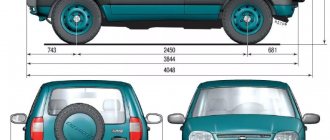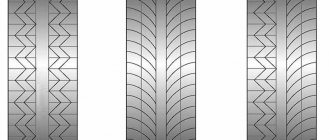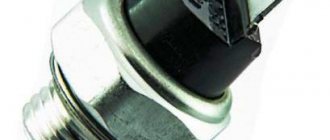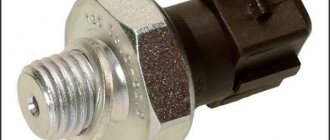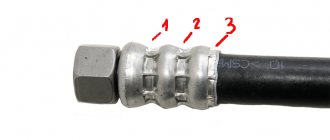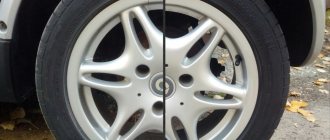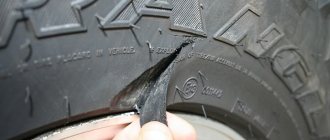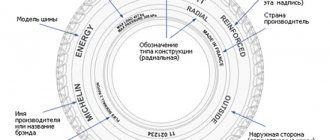How to make tire rims with your own hands?
For any all-terrain vehicle, the decisive condition for excellent cross-country ability is the use of the right tires.
But the cost of a suitable kit is considerable, because it is often produced either in small quantities or by special order.
But it is quite possible to make low-pressure tires yourself . This work is labor-intensive and requires patience and attention. The finished product has a characteristic name - odorishi.
How to rip off the tires for an all-terrain vehicle yourself and how much does a set of rimmed wheels cost?
To improve cross-country ability, the all-terrain vehicle must be equipped with the correct tires. Not everyone can buy factory-made low-pressure tires in a store, because... its cost is high. The way out would be to peel off the tires for the all-terrain vehicle yourself. Although this work is labor-intensive, you can do everything yourself, and the costs will be minimal.
What are buds and what are they for?
Tires (also known as low-pressure tires) are huge tractor, truck or helicopter tires that have been stripped of excess rubber.
Thanks to the large area of such wheels and their low pressure on the surface, an ordinary passenger car equipped with them becomes a real SUV .
With encouragement, Niva and UAZ can overcome a wide variety of obstacles - fields, deserts, rocky and marshy soil.
It is difficult for hunters and simply those who like to ride in difficult terrain to do without wheels with low pressure.
Making such tires yourself is not a problem. For this, the most common tools like a knife or winch . It will still take a little skill.
Before you start creating low-pressure tires, you need to clearly understand what exactly they will be needed for , that is, in what conditions, where exactly they will be used.
- primarily for driving on dirty, bumpy roads and rural roads - then you need to use a self-cleaning tread;
- If we go through swamps on tires, we will need to lower the tread grooves a little so that the grip becomes as good as possible;
- In snow drifts and sand, it is better to drive on tires on which the tread pattern elements are as close to each other as possible.
You need to think about the above in advance.
The process of creating low pressure tires
To make low-pressure tires for a UAZ, Karakat or Niva, you need to create the tire itself, as well as a strong metal base to attach it to.
To create your own wrappers you will need:
- The main material is old tires for trucks such as Gaza-66, Kraza 255 (VI-3 tires), ZIL 131. Tires from helicopters, tractors and small aircraft are also perfect. If the tires have a “chewed” inner part, they should not be used. A hole may form in such rubber after the top layer is removed. As a result, they will simply have to be thrown away.
- An awl, a knife (construction knife), a set of blades and a sharpener for straightening them. When in contact with durable truck tires, the blades quickly dull and become unusable, so you can’t do it alone.
- A special template made of a thin steel sheet or thicker cardboard, as well as chalk or a marker for outlining the template.
- Clamps (maximum strength). The best ones are those that straighteners use to clamp the bodies of crumpled vehicles when they try to straighten them. A standard clamp will also work for stripping tires , but you will need to be very careful. You can use the workflow with ordinary wire cutters.
- A winch (automatic or manual) and a cable to tension the part of the tread that we will cut off. It can also be tightened using a manual gearbox.
You may also need a hammer (for straightening).
To make the tires airy, large tires will need to be freed of excess rubber on the tread and sidewalls. It is also necessary to remove the seat cores and the base of the cord (the inner protective layer of the tire).
- thoroughly clean the tire from all dirt and then dry it;
- using a template, using a marker or chalk along the entire circumference of the wheel, we create a tread pattern (the way it will become after some of the unnecessary rubber is removed).
- We make a cut along the inner perimeter of the tire to get rid of the wire . It is better to make the cut with a construction knife. It is convenient because you can set the length of the blade on it.
- In the area of the cut, mark rectangles with a marker and begin cutting .
- Through the holes formed in the tire we will be able to see the wire, which we will get rid of.
- We fix the tire with an iron rod so that it does not move, and pry up the wire with a hook , and remove it from the tire with a winch. You can also remove it with a screwdriver, but this will require a lot of effort.
Now we start stripping the tire:
- We make cuts along the perimeter of the tread circle we drew , digging a little deeper into the rubberized base of the cord;
- using pliers we fix the resulting hole ;
- and peel off the rubber that has peeled off using a winch .
To make things go easier and faster, we cut it with a knife.
- gradually peel off unnecessary layers of rubber and cord from the tread surface and sides until only one frame remains;
- clean the surface using sandpaper (if necessary, straighten it with a hammer).
The camera for the future wheel is ready.
- We create a new tire frame . We weld the wheel rims with the plates. You can also create low-pressure rims yourself. For this, the most ordinary aluminum basin and fire hose (for fastening) will do.
- Grinding the frame.
- We put the support camera on the frame.
We pump the tire and can install it on our car.
Design options
Since in our case we are interested in the process of making all-terrain tires with our own hands, we will not dwell on factory design options. Types of low-pressure tires that are available for self-production:
- a tube made from a tire of the required size is used as a base. In this case, you can completely make the disk yourself or retrofit the finished wheel with the necessary stops and fasteners. Since the chamber is very elastic, it needs additional support, which will prevent it from breaking under lateral loads. Along the perimeter of the contact patch, the camera is tied with pieces of dense material or chains, which is necessary not only for attaching the camera to the disk, but also to create the effect of lugs. The ability to cling is important not only on sand, loose soil or snow, but also on water;
- Low pressure hydrators. Truck tires are used as a base, from which part of the tread and profile layer is cut off. As a result, the tire becomes lighter and acquires additional elasticity. To reduce the risk of disassembling the wheels when driving at low pressure, as in the previous case, it is necessary to make an additional side stop. We'll look at how to make the pads, as well as the design of the disc, in the photos and videos below.
Chamber version
First of all, you need to select or grind your own discs that will fit the parameters of the hubs of your vehicle. What to do if you need to adjust the width of the disk to the camera:
- cut the disk, cutting out the inner part of the required size, then welding the disks again if it is necessary to reduce the seat size;
- if the width needs to be increased, then a part of another disk is welded between the two cut halves. These wheels can be made to order for you, since making welding joints is a fairly common service.
To manufacture the type of low-pressure wheels we have chosen, metal rods will be required (the safe thickness depends on the size of the chamber, as well as the frequency of the jumpers). The side supports are welded to the base of the disk, and then transverse jumpers are attached to them, which will be the seat on the disk for the camera. For improved lateral support, the entire system is reinforced along the inner perimeter of the tire profile with a circular rod.
Some inventors use chains for jumpers that go around the contact patch. The solution is not bad, since it allows you to get additional snow, water and lugs. You can also use tow ropes, which, after tying, will cover the portion of the camera, preventing it from being damaged.
Advantages and disadvantages
Wheels have many advantages over purchased wheels:
- Price. All-terrain wheels are very expensive, which can’t be said about the wheels.
- Such wheels have excellent adhesion to almost any surface, which significantly reduces the risk of accidents.
- The husks weigh relatively little. An “unpumped” passenger car engine will be quite capable of cranking them.
- Low surface pressure due to the large tire area. With encouragement, muddy terrain, quicksand and deep snow become quite passable obstacles. The tire pressure on the surface can be adjusted. They just need to be pumped up or lowered a little.
- Tires with low pressure do not harm the surface soil layers in any way, so you can safely drive an all-terrain vehicle with tires across plowed fields or use it as a tractor in agriculture.
They are also not without some disadvantages :
- You should try to ride less on hard asphalt and concrete surfaces. Otherwise, they will have to be changed very soon .
- A car on such wheels is not very stable. It’s better not to make sharp turns on it, and you shouldn’t drive it fast at all.
- Wheels wear out much faster than normal ones.
- Encouragement is a considerable burden. Transmission and suspension parts with such wheels will have to be changed and repaired more often.
- Low pressure tires are very flexible. This increases their permeability. But due to their increased stretchability, tires get punctured more often than regular tires.
- The car will have to be re-registered - “upgraded” to the status of an all-terrain vehicle.
Advantages and disadvantages
The main advantages of low pressure tires:
- the cost of a homemade wheel is much less than a similar factory wheel;
- large contact area with the road;
- low specific pressure on the surface, allows you to increase the vehicle's cross-country ability;
- Due to the large diameter, ground clearance increases, which makes it easier to overcome obstacles.
Among their disadvantages it should be noted:
- due to the raising of the vehicle's center of gravity, its handling and stability deteriorate;
- to install such tires, you will have to make adjustments to the design of the car;
- increase the load on the car suspension;
- do not allow you to move at high speed;
- not intended for long-term driving on hard-surfaced roads (asphalt, concrete);
- wear out faster than standard tires.
Making low-pressure wheels with your own hands
Among amateur designers of all-terrain vehicles, low-pressure wheels of their own production are very popular. The beginning of the history of the use of this type of propulsion by enthusiasts of homemade all-terrain vehicles can be considered the mid-sixties of the last century. It was then that the first timid attempts were made to master the production of wheeled vehicles capable of moving with equal success through wetlands and virgin snow. All these machines were equipped with low-pressure pneumatics, and became the ancestors of today's homemade products.
Table: characteristics of off-road tires
| Road conditions | Maximum tire load, kgf | Internal pressure in the tire corresponding to the maximum load, kgf/cm2 | Maximum speed, km/h | Mileage rate within the warranty period, no more, km |
| Paved roads | 600 500 | 0,6 0,5 | 70 | 800 |
| Dirt roads | 600 500 | 0,45 0,35 | 60 | 900 |
| Sand, plowing | 600 500 | 0,3 0,25 | 40 | 1500 |
| Virgin snow | 500 | 0,2 | 20 | 1300 |
Cost of ready-made
There are several manufacturers that produce low-pressure car tires. Let's look at how much these wheels cost:
- . It produces both all-terrain vehicles, swamp vehicles, and wheels for them. Under the influence of an obstacle, the rubber deforms on its own, which ensures high cross-country ability of the vehicle. The price of models 1300x600-533 is 21 thousand rubles, 1350x700-533 - 23 thousand rubles.
- "Belshina". This Belarusian manufacturer strictly adheres to existing standards, and its products have a good price-quality ratio. The cost is 20-25 thousand rubles.
- "Arctictrans". The company produces swamp vehicles, snowmobiles, etc., and also installs standard low-pressure tires on them. The price of the model 1300x530-533 BK is 20 thousand rubles, 900x500-16 -16 thousand rubles.
- "Avtoros". Although this is a young company, it quickly took a leading position among manufacturers of such tires. They are characterized by high quality, reliable fixation on the disc and the ability to continue movement in the absence of pressure. The cost of tires 660/60-21 LT is 23 thousand rubles, 500/60x18 LT is 21 thousand rubles.
- "Vector 4X4". It produces all-terrain vehicles based on Mitsubishi, Toyota, Niva, UAZ, GAZ, etc. It produces wheels on which wheels from other manufacturers can be installed. The price of tires 635-250-R12 is 8-10 thousand rubles.
Table: general characteristics of factory low-pressure tires
| Road surface | Permissible load, kgf | Pressure corresponding to maximum load, kgf/cm² | Maximum speed, km/h | Warranty mileage, km |
| Solid | 600 | 0,6 | 70 | 800 |
| Priming | 600 | 0,45 | 60 | 900 |
| Sand | 600 | 0,3 | 40 | 1500 |
| Snow | 500 | 0,2 | 20 | 1300 |
Distinctive features of low pressure wheels
Why did the designers of caracats like this type of tires made by themselves? The pneumatic has low weight, very high elasticity and pressure on the ground within small limits. All these characteristics, coupled with a large rolling radius, give the all-terrain vehicle amazing maneuverability along with efficiency.
A decent volume of chambers gives the design with such a propulsion sufficient buoyancy. This can be called an additional bonus to the vehicle's cross-country ability. In addition, by filling the inner space of the disk with foam, you can give the all-terrain vehicle additional stability on the water and at the same time reduce the sticking of snow or dirt on the inner surfaces of the wheel.
The simple design of these chassis elements and the absence of problems with finding materials for their manufacture allows you to make a pneumatic passage with your own hands without any special material and labor costs. This made machines built according to this principle very popular among home-made people.
Of course, such designs also have their drawbacks, in particular the short service life of the cameras, but they are overcome by introducing additional elements into the design.
How to make a pneumatic duct from a walk-behind tractor
In order to take on the creation of such an all-terrain vehicle, an amateur designer must solve the following problem: for what purpose is the future vehicle intended. Here you need to clarify the desired number of seats, the weight of the maximum luggage, the season of use and for what conditions the device is intended.
And now the idea is ready, the goal is visible, which means we can move on to the issue of selecting the elements of the all-terrain vehicle. Here you need to decide on the type and model of the engine, the composition of the transmission, the design and type of frame, the equipment of the cabin and other elements. One of the main characteristics that needs to be paid attention to when creating an all-terrain vehicle is the choice of the propulsion system formula.
After analyzing and comparing all desires and possibilities, you can make the final choice of the required all-terrain vehicle design. At this stage of activity, a project for a homemade all-terrain vehicle is a necessary condition for its completion.
Stripping tires for all-terrain vehicles
For such a difficult task you will need not only tires and a garage, but also many related tools. The most necessary ones include:
It’s better to prepare everything in advance so as not to slow down the whole process later. Stripping the wheels will take a long time, so you will need to be patient.
If all the components are available, then you can start. Applying chalk markings is necessary for future drawing of the tread. Moreover, this can be done as much as your imagination allows. But it’s better to draw the simplest one so that there’s less work.
The winch is prepared first; it should be securely attached to the wall or floor. Not far from the winch you will need to equip a tire fixation area. It must be installed and remain stationary while the electric winch is operating. You can make a hole in the concrete floor and insert a crowbar into it, and then put a tire on it. But if your imagination can come up with a more interesting mount, then you shouldn’t hold back. For a stationery knife, you will definitely need replacement blades, since they become dull very quickly during operation.
You may be interested in this About wheel sizes for Lada Granta
Materials for stripping tires
We make a pneumatic walker with our own hands from a walk-behind tractor
Choosing a motor for a pneumatic duct
Very often, the lack of sufficient funding leads to restrictions when choosing an engine, therefore, you have to use what is available. These, as a rule, are two- or four-stroke motorcycle engines, and also use old automobile power plants, but much less frequently. If you still have extra money available and when choosing an engine you don’t have to think about its quantity, then you can use the following recommendations:
Four-stroke engines have a number of advantages over their two-stroke counterparts, which is why many designers use them. For example, you can take boxer engines from heavy motorcycles. In such devices, you can also use a motor from a car, which is most suitable for installing it on a homemade tracked all-terrain vehicle. Such an engine has sufficient torque, is also reliable in use, and it has (and importantly) a good price-to-required performance ratio. What type of engine to use - diesel or carburetor - will be your decision.
Both schemes have their advantages and disadvantages. For example, a diesel engine is more economical than a gasoline engine, although in severe frost conditions it can be difficult to start it stably and make it work stably without using additional equipment (preheater). (What can be said about gasoline engines, but to a much lesser extent).
Design of pneumatic wheels
Designers of all-terrain vehicles in many cases use homemade low-pressure wheels.
What is so unusual about pneumatic tires? They have relatively low weight, high elasticity and pressure on the ground within small limits. Such characteristics, along with a large rolling radius, provide the all-terrain vehicle with good maneuverability along with efficiency.
Factory LP wheels
The volume of the chambers determines good buoyancy for the structure, which is an additional advantage for cross-country ability. And if you use foam to fill the space inside the disk, the all-terrain vehicle will be more stable on the water and there will also be a noticeable reduction in the accumulation of snow or dirt.
The simple design of the chassis elements and the ease of finding materials for them makes it possible to manufacture an all-terrain vehicle without much difficulty. But, of course, this also has its drawbacks, for example, the low lifespan of cameras, but the introduction of additional elements allows this to be avoided. Tires for pneumatic all-terrain vehicles are made by craftsmen themselves, using four basic principles:
- The first - 2 sheet metal disks with jumpers between them are attached to a sleeve, after which you need to put on a camera, which is fixed with pieces of conveyor belt. Sometimes a camera can use a protector from another camera.
- The second is to fasten one disk to the bushing, and then attach jumpers to it, and weld or rivet the side rings to them.
- Third - the scheme is similar to the previous construction principle, only a spoke made of sheet metal or pipe is used for the central disk.
- According to the fourth principle, two discs are mounted on the hub, similar to the discs of a motor scooter wheel (split wheel).
How to install Zhiguli wheels
If you have old spare parts for Lada cars, then there are two options for using them. The first is the creation of lug elements based on discs. This procedure requires the following steps:
- remove and clean the disks;
- weld the plates in a certain order, which will act as lugs;
- install lugs using weights and extensions on the base.
If you use pneumatic tires from Zhiguli, then it is advisable to install winter tires on the walk-behind tractor, which are more aggressive and have greater cross-country ability. If the walk-behind tractor is used for large-area work, then it is necessary to use a paired version or lengthen the axle when installing parts from Zhiguli.
Homemade all-terrain vehicles on a pneumatic walk-behind tractor
Homemade pneumatic vehicles on low-pressure tires are popular due to their versatility and durability: both in summer (karakat on a pneumatic vehicle) and in winter (snowmobile made from a walk-behind tractor), such a unit will always be on the move.
The design of a home-made pneumatic runner is based on the main traction force - the walk-behind tractor. The walk-behind tractor is an engine with a rotating element that allows the use of attachments - a cultivator, a rotary mower, a plow and others. You can often find pneumatics with a trailer - the power of a middle-class unit is even enough to transport a haystack.
In any case, there is no point in buying an expensive mechanism, since the pneumatic duct will still be upgraded to meet specific needs.
Engine selection
The engine power of a homemade pneumatic walker determines the performance of the walk-behind tractor, and therefore, the higher the power, the more efficient the pneumatic walker will work. But there is also a downside: with high power, fuel consumption also increases, and this is not practical if you live far from a gas station. If you plan to use an all-terrain vehicle only in the summer, then it is better to choose a budget model that has a two-stroke engine. It starts quickly and has a simpler design.
For winter fishing or hunting, only a four-stroke is suitable.
Four-stroke walk-behind tractors, thanks to step-by-step stages of activation, warm up gradually, which significantly extends the service life of the pneumatic drive.
Required tools and materials
Since it is necessary to weld metal parts together, you definitely cannot do without a good welding machine!
The list contains the following tools:
- Hammer;
- Screwdriver;
- Metal cutters;
- Drill with drills for metal;
- Grinder with a circle for metal;
- Set of car keys size 10 or 12.
The next step is to purchase the missing materials for a homemade pneumatic runner:
- Walk-behind tractor: you can use the engine from hybrid agricultural equipment;
- Wheels from a car or motorcycle: they are iron, so buy anti-corrosion paint; or homemade/modified depending on needs;.
- Cameras GAZ or others (for example, aviation or from trailed agricultural machines);
- Pipes: any pipes and even their trimmings will do;
- Steering column: it is advisable to purchase a model as new as possible, since the quality of control of a pneumatic all-terrain vehicle depends on this, or use a car rack;
- Hubs: suspension elements must be selected with the least wear, automobile ones can be used;
- Metal corners;
- Fastening elements (bolts, screws);
- Rebar or wire.
Assembling a pneumatic duct on low-pressure tires
Approximate drawing of a pneumatic duct
Before you start assembling a pneumatic walker from a walk-behind tractor with your own hands, make sure that all electrical components are compatible with each other. Be sure to draw up a detailed plan for the implementation of the project, as well as describe the assembly process step by step.
Observe safety precautions when working with a welding machine. Always wear a mask to protect your eyes and cotton gloves.
The installation process can be divided into the following stages:
- Preparing and cleaning the workplace from excess debris and tools.
- After determining the dimensions of the supporting frame, cut pieces of pipes with a grinder and then weld them into a single structure.
- Next, put the cameras on the disks and secure them. Check the tightness of the joints by pumping them with air.
Pneumatic wheel with a rim from an Izh motorcycle and a disk from a Moskvich
- Pay special attention to the design of the pneumatic steering: it must be free of damage and obvious signs of wear. Install the steering and secure it to the frame using a galvanized bolt.
- It's time to connect the drive! Screw the wheels and attach the brake pads to the metal axle.
- Installation of electrical circuits.
- After all the manipulations have been completed, proceed to install the walk-behind tractor. For stationary use, securely fix it with bolts. Now you can understand how your invention will work.
For durability and an attractive appearance of the pneumatic walker made from a walk-behind tractor, the finished structure should be painted with a special protective paint for metal.
DIY pneumatic wheels
Wheels can be of the following types:
- Tire with treads. Tires from a tractor or truck will do. They have a deep pattern that increases the maneuverability of a homemade pneumatic all-terrain vehicle. Often, home-made tires are made lighter by increasing the tread pattern by cutting off excess rubber on the outer layer - such wheels are called “rip-off” or “scuff” wheels.
- A car tube filled with air - low pressure tires. To increase the grip of the pneumatic hose with sand, ice, mud and water, it is necessary to attach metal chains, rings or belts to the chambers - this will give the structure additional rigidity when moving, and also increase maneuverability when cornering.
- Combined, when tires are used together with low pressure chambers.
For wheels, choose galvanized metal cast wheels, despite their cost - they will last much longer than iron ones and will fully pay for themselves in a few years.
To distribute traction more smoothly and evenly while working on a pneumatic track, install a four-speed gearbox from Zhigulenka. This way you can regulate the speed and significantly save fuel consumption.
If you plan to use the pneumatic vehicle at night, be sure to install headlights in the front of the frame: build a box where the generator and battery will be installed.
Buying a pneumatic walker is an expensive pleasure that not everyone can afford, but almost everyone can assemble a homemade pneumatic walker from a walk-behind tractor and scrap materials, saving a lot of money!
Manufacturing of wheels and tires
You can make your own low pressure tire rims and tires. To do this you need to know some of their features. Homemade wheels can be of the following shape:
- arched;
- wide-profile;
- toroidal;
- pneumatic rollers.
Arched structures are designed for off-road travel. They are usually placed on the driving drive of the vehicle. It is recommended to use wide-profile tires up to 700 mm thick as the basis for such a wheel. After processing, its width can become several times larger. Externally, the wheel resembles a barrel. It should be pumped up to a level of 0.05 MPa.
Wide-profile ones have an oval shape. The pressure in them is 2 times lower than standard. Used in heavy-duty vehicles. Quite resistant to rolling.
Toroidal SNDs are manufactured both chambered and tubeless. They are especially in demand among military personnel, hunters and travelers.
Pneumatic rollers have lugs that act as stiffeners. They are characterized by high wear resistance. Work well off-road.
The rims for low-pressure tires (image No. 1) are also homemade. A simple design is a pneumatic and a pair of discs. First, a hub with a seat for bearings is machined. Flanges are attached to it. The parts can be made from sheet steel. Its thickness is from 1 to 3 mm. You can use aluminum alloy grade D 16. Instead of D 16, grade AMG is also used.
Image 3. Threaded fastener.
If you don’t particularly want to do this kind of work, you can take a less difficult path. To do this, just take the wheels from the car. They should be the size you need. For example, these could be the rims of a VAZ car (image No. 2). Threaded fasteners are welded to the rim on the front side (image No. 3). The bolts tightened in them will keep the low pressure tire from turning. The further procedure is as follows:
- spokes are welded to the discs;
- a tube is installed in a circle and secured by welding, forming a hoop;
- the previously made fastening point with the axle is also welded to the disk;
- After all work with an angle grinder, all sharp parts should be removed to protect the camera from punctures.
To make low-pressure tires with your own hands, you need materials and tools (image No. 4):
- tires;
- marker;
- sharp knife;
- sharpener or whetstone for sharpening a knife;
- bolts;
- rubber jumpers;
- winch installed on the base.
Image 4. Tools for making low pressure tires.
It is advisable to have a knife with double-sided sharpening. The tire that is selected as a workpiece must be thoroughly washed and dried. Then it is marked with a marker and the excess material is cut out. To connect to the disk, small windows for bolts are cut out. The cord wire and excess rubber are removed with a winch, since this is very difficult to do by hand. Next, the surface is cleaned with sandpaper, the tire is put on the rims and inflated. This can be done in different ways, depending on the size and shape of the disk.
DIY low-pressure wheels:
- are light in weight;
- have a high degree of elasticity;
- absorbs unevenness well;
- able to overcome swampy areas;
- have a large volume of air, which creates the prerequisites for the buoyancy of the vehicle.
What is a low pressure tire
Special-purpose tires are a way out of a situation when you need to quickly convert an SUV into a full-fledged all-terrain vehicle. The easiest way is to make low-pressure wheels with your own hands. There is nothing complicated in their manufacture, and the price of homemade tires is several times cheaper than factory ones. First, it’s worth understanding the features of such tires and seeing in what cases and on what vehicles their use is most rational.
Equipment on low-pressure wheels is not afraid of swampy terrain, sand, or rocky roads. The pressure in such wheels is about 2 kg/cm2, due to which any obstacle in the path of the tire is overcome thanks to the high elasticity of the rubber and the large volume of air. Branded low-pressure wheels can cost no less than half the entire car, which is why many people make them themselves. Such a tire works in the same way as the wheels on an ATV or a wheeled snowmobile - it distributes the load on the soil more evenly, and due to the large contact area of the tire with any surface, the all-terrain vehicle does not fall through and can move even on loose snow.
Homemade products and Syrians on unusual wheels
Examples of factory vehicles and products produced by folk craftsmen, in the design of which SND are used.
- Industrial:
- Amphibious all-terrain vehicle Tiger XBH 8X8.
- SUV TRACK.
- Homemade:
- Lightweight 4WD car.
- MVH all-terrain vehicle.
As you can see, snowmobiles, swamp vehicles, caracats and ATVs cannot do without SND, the special design of which allows you to easily move along swampy or snowy surfaces. ATVs and cross-country motorcycles also often have similar tires installed. Thanks to them, all-terrain vehicles can traverse rough terrain faster and more efficiently.
Also interesting: The owner revived the dead Lada 4×4 Urban engine by installing a turbine
Varieties
There are several types of low pressure tires.
They are divided into the following categories:
- Arched models. The most common. They have a high profile height. They can be installed on the drive axle of a car, which significantly increases the vehicle’s cross-country ability. Used in conditions of loose snow and swamps. They have a cross-arched section and variable curvature. The sides are low. High-strength polyamide cord is used for the frame. Has low bending resistance.
- Wide-profile. Designed for vehicles with increased load capacity. They are distinguished by their oval shape and excellent rolling resistance. Relevant for machines operated in difficult conditions. They put minimal pressure on the ground, have good shock-absorbing properties, and provide soft suspension operation. Widely used in the agricultural sector. They really don't like asphalt.
- Pneumatic tires. Such rubber has load-bearing hooks, which improves cross-country ability. The most durable types of tires with excellent service life. Made from highly elastic rubber. But the load capacity is small and they wear out quickly on asphalt. But in terms of elasticity it is many times better than previous options when going off-road.
Torroid products. They are divided into tube and tubeless. Mainly used on sports cars. Can be used for everyday use. They have an average profile width. They are more often than others in Russia made with their own hands.
It’s worth taking a closer look at tires when planning to buy them rather than making them yourself.
Existing types
Low pressure wheels may vary depending on their specific purpose. Below are all types of these tires.
Arched
They are the most common and have a high profile height. They can be installed on the drive axle and significantly improve the vehicle's cross-country ability. The shape is arched, the main purpose is heavy roads (loose snow, swamps). They are mounted only on the rear axles of trucks and are used as seasonal tires.
What makes this tire different is its arched cross-section with variable curvature and low sides. The frame is made of durable polyamide cord, thick-layer, with low bending resistance. The magnitude of radial deformation of such rubber is two times higher than that of analogues. Arched tires are rarely equipped with lugs across the entire width of the profile. As a rule, a special belt of one or more hooks is located in the middle of the tread. This reduces tire wear when driving off-road. The advantages of this type of wheels are their large width and low pressure.
Torroid
They come with or without a camera. Most often installed on sports cars. They are also used on a daily basis. The profile width is average.
Wide profile tires
Designed for heavy-duty vehicles, oval shape. The advantage is high rolling resistance. Installed on vehicles that have to travel on difficult roads. Among the features we can also highlight the low pressure on the soil, which improves the springiness and softness of the suspension even on uneven surfaces. That is why wide-profile tire varieties are popular in agriculture.
Pneumatic rollers
These are load-bearing tires that significantly improve cross-country ability. The most durable option among analogues, with a high service life. Pneumatic rollers are made of highly elastic rubber, are characterized by low load capacity and rapid wear on ordinary roads. But in terms of elasticity, they are four times superior to all types of off-road tires. The tread in such wheels is either completely absent or has a low lug height.
Features of the LP off-road tire
Briefly, here are the features of low-pressure wheels:
- The large contact area of the tire with the surface allows the tire efficiency to be increased by 20-25% compared to conventional rubber.
- Versatility. The tire requirements for military equipment and agricultural equipment can be completely different - for a tractor the main thing is the minimum load on the soil, for a military all-terrain vehicle the priority is cross-country ability, but all equipment on low-pressure wheels is capable of overcoming severe off-road conditions, moving through water and swampy areas.
- The peculiarities of driving on low-pressure tires are that driving on concrete and asphalt roads in many cases leads to accelerated tire wear. It is also worth considering that the center of gravity of the all-terrain vehicle can be raised, so there is a danger of tipping over at high speed.
Video
Watch the report from the 12th minute on the capabilities of tubeless tires in overcoming water obstacles: (from about the 13th minute),
And a report on the quality and cross-country ability of tires (from about 5 minutes 40 seconds).
Let us briefly list the main features of products from TREKOL: • Guaranteed long-term operation and high return on investment. • Provides excellent performance on road surfaces. • Thanks to the high displacement of 650 liters, ensuring efficient crossing of water obstacles. • Thanks to the flexible and elastic surface, the tires have reliable protection against damage, unlike models with high pressure.
